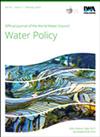Progression of flood risk assessment in India at a decadal scale: a critical review
IF 1.8
4区 环境科学与生态学
Q4 WATER RESOURCES
引用次数: 0
Abstract
Floods are a recurrent natural phenomenon in India, including perennial occurrences in some parts of the country. Progressively, floods are transformed into flood hazards because of the anthropogenic activities in the flood plains and adjoining catchments, causing injuries, loss of lives, and property damage. Flood hazards, when considered in relation to vulnerability and exposure limits, result in associated risk. This article aims to discuss the progression in flood risk assessment through several government policies and actions in India at a decadal scale from 1951 to 2020. While doing this, some important extreme flood events witnessed in those decades that shaped the perspectives, measures, action plans, and policies in the subsequent years are discussed. The review confirms that with the changing patterns of floods, associated hazards, and risks over the years, improvements in risk assessment approaches are noticeable on dual fronts. Technical advancements in flood risk assessment have corroborated the policy reforms. Albeit these developments, the issues related to the scale of study, data sources and resolutions, climatic variability, urban development, complex population dynamics, and their interrelationships in the context of flood risk need to be resolved with serious efforts. Addressing these issues through multidimensional strategies is imperative to aver robust flood risk assessment.印度十年尺度洪水风险评估的进展:批判性审查
洪水是印度经常发生的一种自然现象,在印度的某些地区常年不断。由于洪泛平原和邻近集水区的人为活动,洪水逐渐转化为洪灾,造成人员伤亡和财产损失。洪水灾害与脆弱性和暴露极限相关联,会导致相关风险。本文旨在讨论从 1951 年到 2020 年这十年间,印度通过多项政府政策和行动进行洪水风险评估的进展情况。在此过程中,还讨论了这十年间发生的一些重要极端洪水事件,这些事件影响了随后几年的观点、措施、行动计划和政策。审查证实,随着这些年来洪水、相关灾害和风险模式的不断变化,风险评估方法在两个方面都有明显改善。洪水风险评估技术的进步与政策改革相辅相成。尽管取得了这些进展,但与研究规模、数据来源和分辨率、气候多变性、城市发展、复杂的人口动态以及它们在洪水风险方面的相互关系有关的问题仍需认真加以解决。通过多维战略来解决这些问题,是进行稳健的洪水风险评估的当务之急。
本文章由计算机程序翻译,如有差异,请以英文原文为准。
求助全文
约1分钟内获得全文
求助全文
来源期刊

Water Policy
环境科学-水资源
CiteScore
3.10
自引率
12.50%
发文量
81
审稿时长
6-12 weeks
期刊介绍:
Water Policy will publish reviews, research papers and progress reports in, among others, the following areas: financial, diplomatic, organizational, legal, administrative and research; organized by country, region or river basin. Water Policy also publishes reviews of books and grey literature.
 求助内容:
求助内容: 应助结果提醒方式:
应助结果提醒方式:


